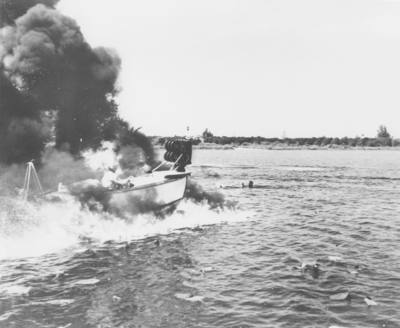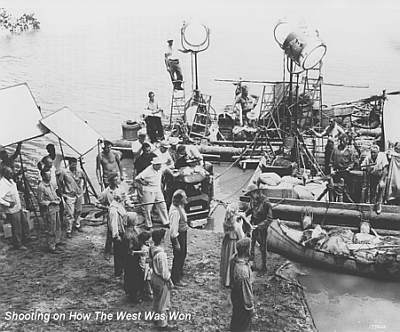|
| cinerama |
|
The idea of exploration infuses the
next release, Search For Paradise
(1957) shot entirely in the rugged
mountain ranges of Katmandu,
where the crew was the first to run
the rapids of the treacherous
Indus River, with 5 times the flow
of the Colorado at its flood. On
the last run, cast member Jim
Parker rode along but didn’t
bother with a life jacket. The raft
flipped, and both Jim and the
camera were lost. Just days
before, he had been heard to
remark, “I wish I could spend the
rest of my life here.”
In 1958, what would be the last
Cinerama travelogue was
released. South Seas Adventure
took a camera crew throughout
the South Pacific on a sailing ship,
recording colorful Polynesian life.
On Pentecost Island, the
production found a tribe who
once a year had a day-long
ceremony where the men would
leap off a one hundred foot tower
with vines tied around their legs
as a test of manhood. This
Cinerama sequence was the first
recorded incidence of bungee
jumping. Pentecost had been
occupied by the Japanese during
the war. They never found the
tribe, but Cinerama did.
1958 also saw the release of a
complementary format film,
Windjammer, which followed the
Norwegian tall ship Christian
Radich around the world. It was
filmed in CineMiracle, which used
three Mitchell cameras converted
to 6-perf pulldown, and
photographed the side panels by
reflecting them in mirrors. This
handily evaded the Cinerama
patents.
 When TIC became the surprise hit
of the 1954 Exposition in
Damascus, completely eclipsing
the Soviet exhibits, the Russians
built their own 3-panel system,
claiming the US had stolen it from
them (of course). Kinopanorama
was a huge hit both in the Soviet
Union, where 15 films were made,
and took prizes at later world
fairs. In 1966, a compilation of
scenes from these films was
released here as Cinerama’s
Russian Adventure. It only played
for a short time in Chicago and
was unseen elsewhere in the
States.
When TIC became the surprise hit
of the 1954 Exposition in
Damascus, completely eclipsing
the Soviet exhibits, the Russians
built their own 3-panel system,
claiming the US had stolen it from
them (of course). Kinopanorama
was a huge hit both in the Soviet
Union, where 15 films were made,
and took prizes at later world
fairs. In 1966, a compilation of
scenes from these films was
released here as Cinerama’s
Russian Adventure. It only played
for a short time in Chicago and
was unseen elsewhere in the
States.
Twilight
The five-year contract with Stanley
Warner had expired and Lowell
Thomas hoped for a change in
management – for the better. For
a time, it seemed as though it
might happen. The company was
acquired by Nicolas Reisini, an
import/export tycoon who had
been entranced with Napoleon
and had a real vision for the
company.
His first idea was a good one –
Itinerama. He put Cinerama on
trucks, and took it all over Europe
to the countryside where there was
no theater nearby. A tent was put
up, and 3,000 people could view
a Cinerama film. And so it was
that one memorable night in
France, Abel Gance, who had the
idea nearly 40 years before, was
the guest of honor at a Cinerama
screening.
Reisini also began an aggressive
global building campaign. Over
200 purpose-built theaters were
planned, to bring Cinerama to the
world. When the Tokyo theater
opened, it was such an event that
even the Emperor came.
Reisini’s second idea wasn’t bad,
either. He made a co-pro deal
with MGM for a string of
traditional dramatic films. George
Pal brought his special touch to
The Wonderful World of the
Brothers Grimm, a bio-pic
interspersed with dramatizations
of their fairy tales. It featured
several visual effects and was
moderately successful. But it was the classic How The
West Was Won which would
become the crown jewel of
Cinerama, the last 3-panel film,
and the highest grossing film of
1962, just as TIC had been 10
years before.
HTWWW was a multi-generational
story which followed the Prescott
family as they headed West. Shot
entirely on wilderness locations
with several units, an all-star cast,
and three directors over a two
year period, it was a major
achievement for director general
Henry Hathaway, who studied the
Cinerama process in depth and
learned how to work around its
limitations.
But it was the classic How The
West Was Won which would
become the crown jewel of
Cinerama, the last 3-panel film,
and the highest grossing film of
1962, just as TIC had been 10
years before.
HTWWW was a multi-generational
story which followed the Prescott
family as they headed West. Shot
entirely on wilderness locations
with several units, an all-star cast,
and three directors over a two
year period, it was a major
achievement for director general
Henry Hathaway, who studied the
Cinerama process in depth and
learned how to work around its
limitations.
Hathaway proved that the process,
thought difficult and expensive,
could be effective with the right
property. It is a taste of what
might have followed. If only…
Unfortunately, Reisini’s vision had
expanded faster than his revenues.
His 360° consumer camera wasn’t
selling, nor his home video tape
recorder. The company, unfamiliar
with studio accounting practices,
had taken a bath in “overhead”
charges on HTWWW. When the
70mm comedy It’s a Mad, Mad,
Mad, Mad World proved a
success, he decided the 3-panel
process was just too expensive and
made all future films in either
Technirama or Super Panavision
70, hoping to trade on the
established marquee value of the
Cinerama name. Of course,
audiences weren’t fooled by this
bastardization of the process – it
was impossible not to notice that
there was only one projector.
Several subsequent films were
advertised as being “in Cinerama”
among them Khartoum, Grand
Prix, and Ice Station Zebra.
Originally contracted for 3-panel,
2001 was shot in 70mm when
effects supervisor Douglas
Trumbull saw the long, slender
design for the Discovery
spacecraft and knew it would kink
badly at the blend lines. The
Greatest Story Ever Told actually
began production in 3-panel, but
after a few days director George
Stevens was talked into using Ultra-Panavision by ill-informed
advisors.
|
|